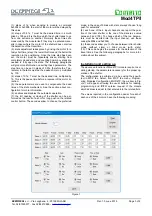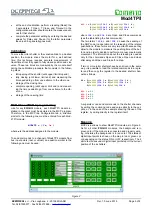
Contatto
Mod4TP/I
Information form and to Mod4TP
Mod4TP/I module, as said above, takes an input and an
output address, 4-channel 16-bit; the following tables list
the information mapped on these addresses:
Input section:
IN
Point
CH1
CH2
CH3
CH4
1
S
hu
tte
r/
S
la
ts
p
os
iti
o
n
1
S
hu
tte
r/
S
la
ts
p
os
iti
o
n
2
S
hu
tte
r/
S
la
ts
p
os
iti
o
n
3
S
hu
tte
r/
S
la
ts
p
os
iti
o
n
4
2
3
4
5
6
7
8
9
IN1
IN3
IN5
IN7
10
IN2
IN4
IN6
IN8
11
-
-
-
-
12
-
-
-
-
13
MOT1 Up
MOT2 Up
MOT3 Up
MOT4 Up
14
MOT1 Dw
MOT2 Dw
MOT3 Dw
MOT4 Dw
15
MOT1 ON
MOT2 ON
MOT3 ON
MOT4 ON
16
CAL. 1
CAL. 2
CAL. 3
CAL. 4
Shutter/Slats position n
: the 8 least significant bits of
each channel report, as a number between 0 and 100, the
position of the roller shutter or the position of the slats posi-
tion depending on the last selection made by the command
0x20 (see output section that follows). The position 0 is ful-
ly open, 100 is fully closed.
IN1..IN8
: the points 9 and 10 of each channel report the
status of the related input 1..8 of the module.
MOTn Up, MOTn Dw
: points 13 and 14 of each channel
will be activated when the related motor is running in for
opening or closing respectively; these points allow to report
the motors status.
MOTn ON
: point 15 of each channel will be activated when
the related motor is running; this point allows to show if a
motor is currently driven or not (in practice it is the logic
sum of point 13 and 14 described before).
CAL. n
: point 16 of each channel will be activated when the
calibration of the related shutter is running (detection of the
travel time).
Output section:
OUT
Point
CH1
CH2
CH3
CH4
1
V
al
ue
1
V
al
ue
2
V
al
ue
3
V
al
ue
4
2
3
4
5
6
7
8
9
C
o
m
m
an
d
1
C
o
m
m
an
d
2
C
o
m
m
an
d
3
C
o
m
m
an
d
4
10
11
12
13
14
15
16
The 4 output channels allow to send several commands
and settings to the module.
The executed function depends on the Command code and
on the Value as described in the following table (in hexa-
decimal format).
Com.
Val.
Function
0x00
0x00
NOP (no operation)
0x01
Open
0x02
Close
0x04
Open after a programmed delay
0x08
Close after a programmed delay
0x10
Stop
0x11
Open for 1 step time
0x12
Close for 1 step time
0x01
P
Move shutter to position P (0..00%)
0x02
P
Move slats to position P (0..100%)
0x11
T
Set opening/closing delay to T (0-255s) (1)
0x12
T
Set opening/closing timeout to T (0-255s) (1)
0x13
T
Set opening time to T (0.00-240.00s) (2)
0x14
T
Set closing time to T (0.00-240.00s) (2)
0x15
N
Set number of step N (0-255) for slats (3)
0x16
T
Set step time T for slats (0.00-2.55s) (3)
0x17
T
Set pause time (0.0-25.5s) (4)
0x18
N
Slats dead time at 0% in step number (0-255) (5)
0x19
N
Slats dead time at 100% in step num. (0-255) (5)
0x20
0x00
Disable automatic function (6)
0x01
Enable automatic function (6)
0x02
Set short push for automatic (7)
0x03
Set long push for automatic (7)
0x04
Report shutter position on input CH (8)
0x05
Report slats position on input CH (8)
0x06
Set shutter mode (no slats) (9)
0x07
Set blind mode (with slats) (9)
0xAA
0x55
Execute calibration (10)
The commands for parameter settings (Com. 0x11 to 0x20)
are useful for a supervisor; normally, the module has to be
set using the related configuration panel in MCP Ide pro-
gram (see the related paragraph).
DUEMMEGI
s.r.l. - Via Longhena, 4 - 20139 MILANO
Tel. 02/57300377 - Fax 02/55213686 –
www.duemmegi.it
Rel.: 1.0 June 2016
Page 2 of 6






